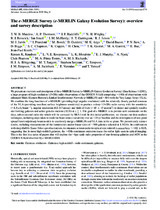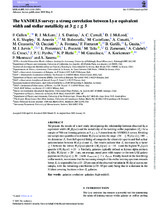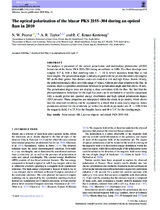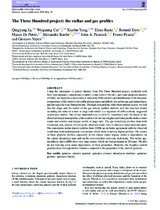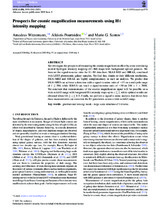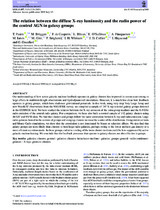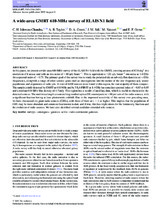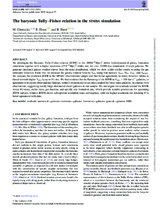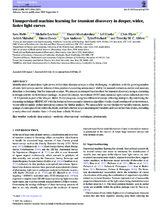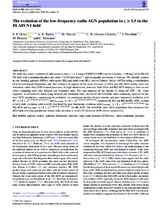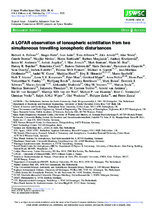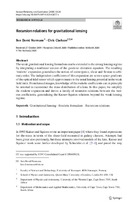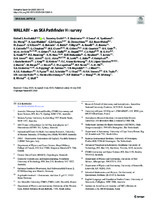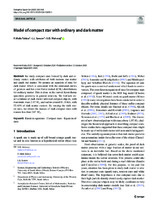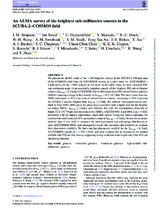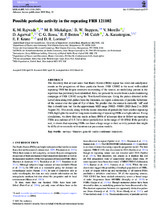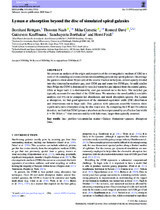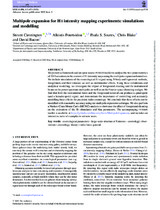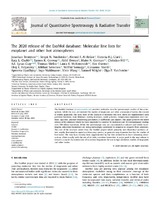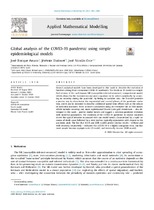Physics and Astronomy: Recent submissions
Now showing items 381-400 of 520
-
The e-MERGE Survey (e-MERLIN Galaxy Evolution Survey): Overview and survey description
(Oxford University Press, 2020)We present an overview and description of the e-MERGE Survey (e-MERLIN Galaxy Evolution Survey) Data Release 1 (DR1), a large program of high-resolution 1.5-GHz radio observations of the GOODS-N field comprising ∼140 h of ... -
The VANDELS survey: a strong correlation between Ly α equivalent width and stellar metallicity at 3 ≤ z ≤ 5
(Oxford University Press, 2020)We present the results of a new study investigating the relationship between observed Ly α equivalent width (Wλ(Ly α)) and the metallicity of the ionizing stellar population ( Z⋆) for a sample of 768 star-forming galaxies ... -
The optical polarization of the blazar PKS 2155–304 during an optical flare in 2010
(Oxford University Press, 2020)An analysis is presented of the optical polarimetric and multicolour photometric (BVRJ) behaviour of the blazar PKS 2155–304 during an outburst in 2010. This flare develops over roughly 117 d, with a flux doubling time τ ... -
The three hundred project: The stellar and gas profiles
(Oxford University Press, 2020)Using the catalogues of galaxy clusters from The Three Hundred project, modelled with both hydrodynamic simulations (GADGET-X and GADGET-MUSIC), and semi-analytical models (SAMs), we study the scatter and self-similarity ... -
Prospects for cosmic magnification measurements using H I intensity mapping
(Oxford University Press, 2020)We investigate the prospects of measuring the cosmic magnification effect by cross-correlating neutral hydrogen intensity mapping (H I IM) maps with background optical galaxies. We forecast the signal-to-noise ratio for ... -
The relation between the diffuse X-ray luminosity and the radio power of the central AGN in galaxy groups
(Oxford University Press, 2020)Our understanding of how active galactic nucleus feedback operates in galaxy clusters has improved in recent years owing to large efforts in multiwavelength observations and hydrodynamical simulations. However, it is much ... -
A wide-area GMRT 610-MHz survey of ELAIS N1 field
(Oxford University Press, 2020)In this paper, we present a wide-area 610-MHz survey of the ELAIS N1 field with the GMRT, covering an area of 12.8 deg2 at a resolution of 6 arcsec and with an rms noise of ∼40 μJy beam−1. This is equivalent to ∼20 μJy ... -
The baryonic Tully–Fisher relation in the SIMBA simulation
(Oxford University Press, 2020)We investigate the Baryonic Tully–Fisher relation (BTFR) in the (100h−1Mpc)3SIMBA hydrodynamical galaxy formation simulation together with a higher resolution (25h−1Mpc)3SIMBA run, for over 10 000 disc-dominated, H I-rich ... -
Unsupervised machine learning for transient discovery in deeper, wider, faster light curves
(Oxford University Press, 2020)Identification of anomalous light curves within time-domain surveys is often challenging. In addition, with the growing number of wide-field surveys and the volume of data produced exceeding astronomers’ ability for manual ... -
The evolution of the low-frequency radio AGN population to z 1.5 in the ELAIS N1 field
(Oxford University Press, 2021)We study the cosmic evolution of radio sources out to z ≃ 1.5 using a GMRT 610 MHz survey covering ∼1.86 deg2 of the ELAIS N1 field with a minimum/median rms noise 7.1/19.5 μJy beam−1 and an angular resolution of 6 arcsec. ... -
A LOFAR observation of ionospheric scintillation from two simultaneous travelling ionospheric disturbances
(The Journal of Space Weather and Space Climate, 2020)This paper presents the results from one of the first observations of ionospheric scintillation taken using the Low-Frequency Array (LOFAR). The observation was of the strong natural radio source Cassiopeia A, taken ... -
Recursion relations for gravitational lensing
(Springer Nature, 2019)The weak gravitational lensing formalism can be extended to the strong lensing regime by integrating a nonlinear version of the geodesic deviation equation. The resulting ‘roulette’ expansion generalises the notion of ... -
WALLABY – an SKA Pathfinder H I survey
(Springer Nature, 2020)The Widefield ASKAP L-band Legacy All-sky Blind surveY (WALLABY) is a next-generation survey of neutral hydrogen (H I) in the Local Universe. It uses the widefield, high-resolution capability of the Australian Square ... -
Model of compact star with ordinary and darkmatter
(Springer Nature, 2020)We study compact stars formed by dark and ordinary matter, with attributes of both neutron star matter and quark star matter. We assume an equation of state for dark matter which is consistent with the rotational ... -
An ALMA survey of the brightest sub-millimetre sources in the SCUBA-2–COSMOS field
(Oxford University Press, 2020)ABSTRACT We present an ALMA study of the ∼180 brightest sources in the SCUBA-2 850-μm map of the COSMOS field from the S2COSMOS survey, as a pilot study for AS2COSMOS – a full survey of the ∼1000 sources in this field. ... -
Possible periodic activity in the repeating FRB 121102
(Oxford University Press, 2020)The discovery that at least some Fast Radio Bursts (FRBs) repeat has ruled out cataclysmic events as the progenitors of these particular bursts. FRB 121102 is the most well-studied repeating FRB but despite extensive ... -
Lyman α absorption beyond the disc of simulated spiral galaxies
(Oxford University Press, 2020)We present an analysis of the origin and properties of the circumgalactic medium (CGM) in a suite of 11 cosmological zoom simulations resembling present-day spiral galaxies. On average the galaxies retain about 50 per cent ... -
Multipole expansion for H I intensity mapping experiments: simulations and modelling
(Oxford University Press, 2020)We present a framework and an open-source PYTHON toolkit to analyse the two-point statistics of 3D fluctuations in the context of H I intensity maps using the multipole expansion formalism. We include simulations of the ... -
The 2020 release of the ExoMol database: Molecular line lists for exoplanet and other hot atmospheres
(Elsevier, 2020)The ExoMol database (www.exomol.com) provides molecular data for spectroscopic studies of hot atmospheres. While the data are intended for studies of exoplanets and other astronomical bodies, the dataset is widely applicable. ... -
Global analysis of the COVID-19 pandemic using simple epidemiological models
(Elsevier, 2021)Several analytical models have been developed in this work to describe the evolution of fatalities arising from coronavirus COVID-19 worldwide. The Death or ‘D’ model is a simplified version of the well-known SIR ...

